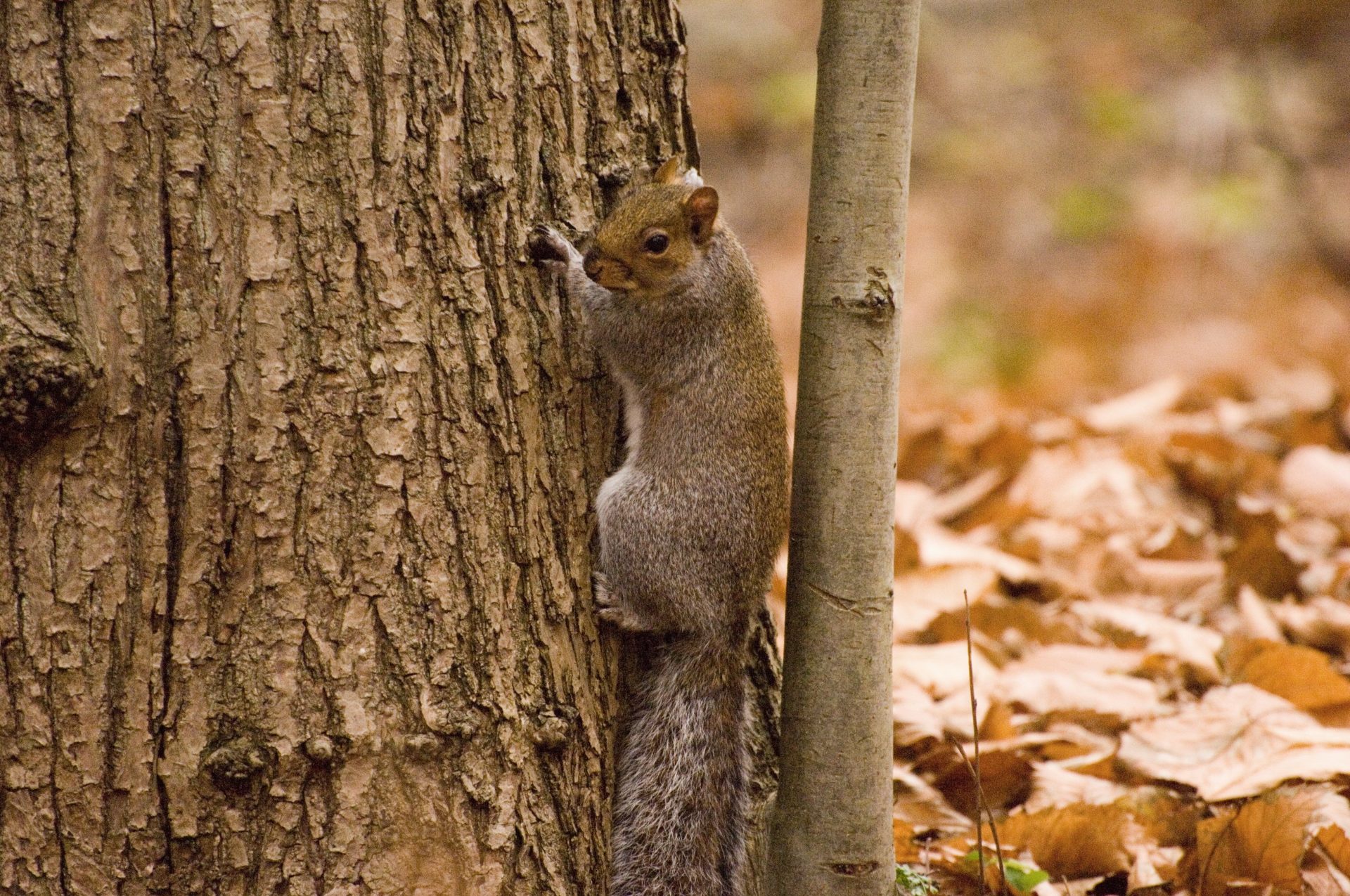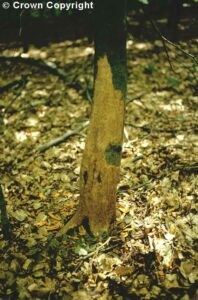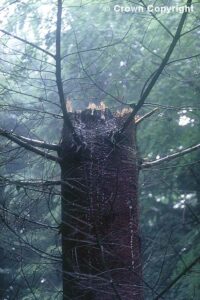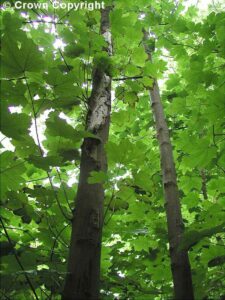Summary
Since their introduction into Britain between 1876 and the 1920s, grey squirrels have spread rapidly, gradually displacing the native red squirrel through a combination of competition for food and transmission of the squirrel pox virus. Grey squirrels now occur in most of England and Wales, and in central and south-east Scotland.
Grey squirrels are extremely destructive in woodlands, stripping bark from the main stem and branches of trees. Typically beech and sycamore trees are most severely damaged, however serious damage can occur on a wide range of tree species, including oak, birch, larch, pines and Norway spruce. Bark wounds can result in deformation, stain and decay of the timber and serious wounds can kill the tree. Squirrel damage has now become a serious disincentive to landowners trying to establish new woodland.

Research Objectives
The overall aims of this research programme include:
- Investigating the impact of grey squirrels on woodlands and the reasons for bark stripping behaviour
- Supporting the development of novel control strategies
- Promoting and supporting best practice management for the control of grey squirrels and their impacts
Specific objectives included:
- Investigating the motives for bark stripping behaviour and the factors affecting selection for particular trees. This is a collaborative project with Southampton University: https://www.forestprotection.uk/project/2213_squirrel/
- Investigate the impact of pine martens on numbers and behaviour of grey squirrels
- Develop novel approaches for monitoring squirrel populations and their impact
- Support the development of novel methods of population control including new trapping methods, contraception, gene editing and natural predation
- Investigating alternative methods of damage limitation such as stand management
- Support evidence based policy development at national and regional levels
- Provide practical advice to the forest industry and the public to promote best practice
Findings and Recommendations
Bark stripping damage to trees by grey squirrels
Impact
Bark stripping damage reduces timber quality through staining (due to fungal infection) and structural defects and ultimately reduces timber value and yield. Weakened stems may break and trees that are ring-barked will die from that point up.
Damage varies across sites and between years and is difficult to predict. Thin barked species such as sycamore, beech, oak, sweet chestnut, pine, larch and Norway spruce are most at risk with trees aged between 10 and 40 years being most vulnerable.
Examples




Manufacturers and suppliers of equipment for grey squirrel control
This list is not exhaustive and does not reflect a recommendation from us for a particular supplier or product.
| Manufacturer or supplier | Trap types | Other equipment | |
|---|---|---|---|
| Cage | Spring | ||
| Albion Manufacturing The Granary Silfield Road Wymondham Norfolk, NR18 9AU Tel: 01953 605983 Fax: 01953 606764 sales@albionmanufacturing.com www.albionmanufacturing.com/ |
|
Hopper labels | |
| Barrettine Environmental Health St Ivel Way Warmley Bristol, BS30 8TY Tel: 0117 967 2222 Fax: 0117 961 4122 sales@barrettine.co.uk www.barrettine.co.uk/ |
|
|
Hopper labels |
| Gamekeepa Feeds & Supplies Ltd Gamekeepa Feeds & Supplies Ltd Raddle lane Edingale Tamworth Staffordshire B79 9JR Tel: +44(0)1827 383993 Fax: +44(0)1827 382810 Mob: +44(0)7836512446 ian.garland@gamekeepafeeds.co.uk www.gamekeepafeeds.co.uk |
|
|
Drey-poking poles |
| Janus Contract Services Ltd Mounts Farm Shalford Road Rayne Braintree Essex, CM7 5XA Tel: 01376 342111 sales@januslimited.co.uk www.januslimited.co.uk |
|
Fenn trap Mk.4 |
|
| John Dee Humane Traps Unit 4 Russett Cottage Greendale Barton Woodbury Salterton Exeter, EX5 1EW Tel: 01395 233340 Fax: 01395 233548 |
Mink/squirrel single capture | Fenn trap Mk.4 | |
| Killgerm Chemicals Ltd PO Box 2 Ossett West Yorkshire WF5 9NATel 01924 268400 Fax 01924 264757 sales@killgerm.com www.killgerm.co.uk/ Training information tel: 01924 268445 |
|
|
|
| Network Pest Control Systems Ltd 1030 Centre Park Slutchers Lane Warrington Cheshire WA1 1QR |
|
Springer No. 4 | |
| Rhemo Products Ltd Unit 26 Wick 2 Industrial Estate, Gore Road New Milton Hants BH25 6TJ rhemoproducts@newmilton.wanadoo.co.uk |
|
Magnum trap tunnel (for spring trap) | |
| Camlab Limited Norman Way Over Cambridge, CB4 5WE Tel: 01954 233110 Fax:1954 233101 sales@camlab.co.uk www.camlab.co.uk/ |
Electronic pocket balance: Tanita model No. 1475 Part number: ME/6602-3071 |
||
Further information
Links to further information
Manufacturers and suppliers of equipment for grey squirrel control
Research on contraception for grey squirrel control:
Red Squirrel conservation:
Saving Scotland’s Red Squirrels | Scottish Wildlife Trust
Where to find red squirrels – Red Squirrel Survival Trust (rsst.org.uk)
Forestry Commission publications
Gill, R., Ferryman, M., Shuttleworth, C. Lurz, P., Mill, A., Robertson, P. and Dutton, C. (2019) Controlling Grey squirrels. UK Forestry Standard Technical Note 022.
Bryce, J., Cartmel, S. and Quine, C. P. (2005). Habitat use by red and grey squirrels: results of two recent studies and implications for management (PDF-546 KB). Forestry Commission Information Note 76. Forestry Commission, Edinburgh.
Mayle, B. A. (2004) Grey squirrel management in woodlands, in Managing woodlands and their mammals (Quine, C., Shore, R. & Trout, R., Eds.): proceedings of a symposium organised jointly by the Mammal Society and the Forestry Commission, 45-49, Forestry Commission, Edinburgh.
Gurnell, J., Lurz, P.W.W., Pepper, H. (2001) Practical techniques for surveying and monitoring squirrels (PDF-3830 KB), Forestry Commission Practice Note 11, Forestry Commission, Edinburgh.
Pepper, H., Bryce, J., Cartmel, S. (2001), Squirrel management: 2. Co-existence of red squirrels and grey squirrels, in Forest Research Annual Report and Accounts 1999-2000. Forestry Commission, Edinburgh.
Pepper, H., Moore, H. (2001) Squirrel management: 1. Development of a contraceptive vaccine for the grey squirrel, in Forest Research Annual Report and Accounts 1999-2000. Forestry Commission, Edinburgh.
Pepper, H., Patterson, G. (2001) Red squirrel conservation (PDF-250 KB), Forestry Commission Practice Note 5 (revised). Forestry Commission, Edinburgh.
Pepper, H. (1998) Nearest neighbour method for quantifying wildlife damage to trees in woodland (PDF-139 K), Forestry Commission Practice Note 1. Forestry Commission, Edinburgh.
Other publications
Gill, R., Massei, G., Pinkham, R., Beatham, S., Whitelaw, B., McNicol, C. (2021) Grey Squirrel Control Research – what new approaches may we anticipate for the future? Quarterly Journal of Forestry, Jan 2022
McNicol, C., Bavin, D., Goodwin, C. Silk, M., Macpherson, J., Gill, R., Ferryman, M., Bearhop, S., McDonald, R. (2019) Translocated native pine martens Martes martes affect space use by invasive non-native grey squirrels Sciurus carolinensis. J. Applied Ecology. 57(5) DOI: 10.1111/1365-2664.13598
McNicol, C.M., Bavin, D., Bearhop, S., Bridges, J., Croose, L., Gill, R., Goodwin, C., Lewis, J., Macpherson, J., Padfield, D., Schofield, H., Silk, M., Tomlinson, A., & McDonald, R. (2020) Post-release movement and habitat selection of translocated pine martens Martes martes Ecology and Evolution DOI: 10.1002/ece3.6265
Shuttleworth, C. and Gill, R. (2019) Red squirrel bark-stripping of hornbeam in North Wales. Quarterly Journal of Forestry.
Inward, D., Reed, K., Gill, R. (2019) Chapter 3. Pest threats to UK Oak health. In: Quine, C.P., Atkinson, N., Denman, S., Desprez-Loustau, M-L., Jackson, R., Kirby, K. (eds) 2019. Action Oak Knowledge review: an assessment of the current evidence on oak health in the UK, identification of evidence gaps and prioritisation of research needs. Action Oak and Forest Research, Farnham, UK
Shuttleworth, C., Bertolino, S.,Gill, R., Gurnell, J., Hayward, M.,Kenward, R., Lawton, C., Lurz, P., McInnes, C., Mill, A., Trotter, S., Wauters, L. (2019) Releasing Grey Squirrels into the wild. Vet. Record. http://dx.doi.org/10.1136/vr.l1270.
Stringer AP, MacPherson J, Carter S, Gill R, Ambrose-Oji B, Wilson R, Kelsall P, Feirn WG, Galbraith LC, Hilário CM, Parry G & Taylor A. (2018) The feasibility of reintroducing pine martens (Martes martes) to the Forest of Dean and lower Wye Valley. Gloucester Wildlife Trust, May 2018. 107 pages.
Dunn, M., Marzano, M. Forster, J., Gill R.M.A. (2018) Public attitudes towards “pest” management: perceptions on squirrel management strategies in the UK. Biological Conservation 222, 52-63.
Nichols, C.P., N. G. Gregory, N. Goode, R. M. A. Gill, J. A. Drewe. (2018) Regulation of bone mineral density in the grey squirrel, Sciurus carolinensis: Bioavailability of calcium oxalate, and implications for bark stripping. J Anim Physiol Anim Nutr. 2018;102:330–336. https://doi.org/10.1111/jpn.12740
Nichols, C.P., Gregory, N.G., Goode, N., Gill, R.M.A., and Drewe, J.A.(2017) Can the grey squirrel, Sciurus carolinensis, utilise calcium oxalate? – Implications for bark stripping behaviour Journal of Animal Physiology and Animal Nutrition. DOI: 10.1111/jpn.12740
Nichols, C.P. and Gill, R.M.A. (2016) Bark stripping behaviour by the grey squirrel, Sciurus carolinensis. Chapter 19 in: Shuttleworth, C. and Gurnell, J. (Eds) The Grey Squirrel. The European Squirrel Initiative.532p
Nichols, C.P., Gill, R.M.A., Drewe, J.A. Goode, N. Gregory, N. (2016) A novel causal mechanism for grey squirrel bark stripping: The Calcium hypothesis. Forest Ecology and Management. 367 12-20.
Mayle, B., Ferryman, M., Peace, A., Yoder, C., Miller, L., Cowan, D., (2013) The use of DiazaCon™ to limit fertility by reducing serum cholesterol in female grey squirrels, Sciurus carolinensis. Pest Management Science 69, 414-424.
Mayle, B.A. and Broome, A. (2013) Changes in the impact and control of an invasive alien, the grey squirrel Sciurus carolinensis, as determined from regional surveys. Pest Management Science, 69, 323-333.
Willoughby, I., Jinks, R.L., Morgan, G.M., Pepper, H., Budd, J. and Mayle, B.M. (2011). The use of repellents to reduce predation of tree seed by wood mice (Apodemus sylvaticus L.) and grey squirrels (Sciurus carolinensis Gmelin). European Journal of Forest Research. 130, 4, 601-611.
Yoder, C. A., Mayle, B.A., Furculow, C.A., Cowan, D,P. & Fagerstone, K.A. (2011). Feeding of grey squirrels (Sciurus carolinensis) with the contraceptive agent DiazaCon: effect on cholesterol, hematology, and blood chemistry. Integrative Zoology 6: 409-419.
Mayle, B. A., Proudfoot, J., Poole, J. (2009). Influence of tree size and dominance on incidence of bark stripping by grey squirrels to oak and impact on tree growth. Forestry 2009,82,4, 431-444.
Ferryman, M., Mayle, B. A. and Morgan, G. W. (2006). Visual method for evaluating the state of sexual development in male grey squirrels (Sciurus carolinensis). Reproduction, Fertility and Development 18, 383-393.
Mayle, B. A. (2005). Britain’s woodlands under threat; Grey squirrels and the risk they pose to European woodlands. Trees, Journal of the International Tree Foundation. 65 9-11.
Pepper, H.W., G. Kerr (2005). Preliminary studies on collars to protect trees from grey squirrel bark-stripping damage. Quarterly Journal of Forestry 99(2): 105-112.
Gurnell, J., Lurz, P.W.W., Shirley, M.D.F., Cartmel, S., Garson, P.J., Magris, L., Steele, J. (2004) Monitoring red squirrels (Sciurus vulgaris) and grey squirrels (Sciurus carolinensis) in Britain, Mammal Review. 34, 51-74.
Hewson, C., Fuller, R., Mayle, B., Smith, K. (2004) Possible impacts of grey squirrels on birds and other wildlife. British Wildlife 15, 183-191.
Mayle, B., Gurnell, J. (2004) Squirrel control in conifers, Forestry and British Timber, April 2004, 16-19.
Gurnell, J., Mayle, B.A. (2003) Ecological impacts of the alien grey squirrel (Sciurus carolinensis) in Britain, conference proceedings: MammAliens – a one-day conference on the problems caused by non-native British mammals, 40-45, Mammals Trust UK.
